Learn how to make homemade carbonated water carbonated stored in a kegerator!
What is it about fizz that turns a drink from boring to brilliant?
Having sparkling water on tap is perfect when you want something exciting and refreshing but without any calories or alcohol.
And for those who find drinking water during the day a chore, it’s now like a reward!
How To Make Homemade Carbonated Water
Having said all that, you’re probably not going to go to the lengths of making homemade carbonated water this way unless you’re already a homebrewer who kegs.
Making sparkling water costs pennies.
It’s about 1.5 cents per 12oz glass (plus the cost of any flavored ingredients you add) compared to dollars per bottle commercially, but the equipment is probably not worth the investment unless you want to start putting beer on tap too!
All About Kegs For Sparkling Water Storage
The soda industry used to use these kegs (called “cornelius kegs” after one of the manufacturers) to deliver soda to restaurants.
Nowadays, they deliver a box of syrup that gets mixed in-line with carbonated water in the system.
Lucky for us homebrewers, that opened a world of used kegs to us that are perfect sized for homebrew batches.
Step 1: Start By Cleaning Your Keg
Each keg holds five gallons.
First I clean them thoroughly, taking all the hardware apart and soaking in a cleaner similar to oxyclean.
Then I sanitize with a homebrew sanitizer.
This thoroughness is honestly probably not necessary for sparkling water, but I do it because these kegs will also be used to hold beer at some point, and contamination from unwanted microorganisms can quickly ruin a batch of beer.
(See my post with pumpkin beer recipes!)
Step 2: Fill With Ice Water
I then fill it almost to the brim with ice water.
To chill five gallons of water you’ll probably need about 5-10 pounds of ice.
Alternatively, you can just fill the keg and let it sit in a fridge for ~24 hours.
Leave about a quart or two of headspace inside the keg – it will make carbonating easier.
It will also carbonate easier if you get it as close to 32 degrees as possible.
Step 3: Add Flavors To The Water
Now’s a great time add any flavorings.
There are so many options out there and you really can’t go wrong.
Keep it light at first because at worst you’ll just have sparkling water that doesn’t taste like anything, but overdoing it is a bummer.
One of my favorites has been this lemonade for a very subtle raspberry sparkling water:
Another classic option is to strain the juice from a bunch of citrus fruits.
Try a lime, lemon, and two oranges together.
Or you can soak fresh mint in green tea at room temperature for 24 hours and then dose your water as desired. The sky’s the limit!
I started with 1.5 cups of this lemonade but sometimes all it takes is a quarter cup of something very strong.
I ended up adding another half cup later on for a boost in flavor.
Step 4: Carbonate Water with CO2
Now that you have cold, flavored water, it’s time to carbonate.
You’ll need a CO2 tank and regulator, plus the appropriate fittings to connect to the keg.
Many homebrewing websites sell a starter kegging kit that includes the tank, regulator, fittings, and one keg, and they usually run about $180-200.
Once hooked up, I turn the PSI up to almost 30.
Step 5: Shake To Carbonate!
No seriously! We’re taking advantage of the fact that gas will dissolve into a solution when under pressure.
Shaking the keg just moves the water around and exposes the surface area to the CO2 that is being pushed into the keg.
This is why you want to leave a quart or two of open space inside the keg – that’s a lot of surface area that can be moved around.
Turning it on its side makes it easier to move around. It takes about five minutes.
I’ll gladly look stupid for five minutes to have sparkling water on tap!
Check it every couple of minutes to know when you’re getting close.
Unlike beer, water doesn’t create any foam to explode out of the tap so it’s easy to check.
Step 6: Adjust Serving Pressure
Once it’s fully carbonated, I reduce to a serving pressure of about 12 PSI. This is the same pressure at which I serve my beers.
Some homebrewers will get super fancy and have extra equipment to maintain the high pressure but I find that a normal amount of carbonation is plenty refreshing and tasty.
Check out this chart for pressure/temperature recommendations for serving.
I usually aim for around 2.2 volumes of CO2.
Step 7: Store Your Homemade Carbonated Water In A Kegerator
When ready I plop it into the kegerator!
That’s a whole ‘nother build itself, but I pretty much followed these instructions to the letter.
Go forth and live your life refreshed!


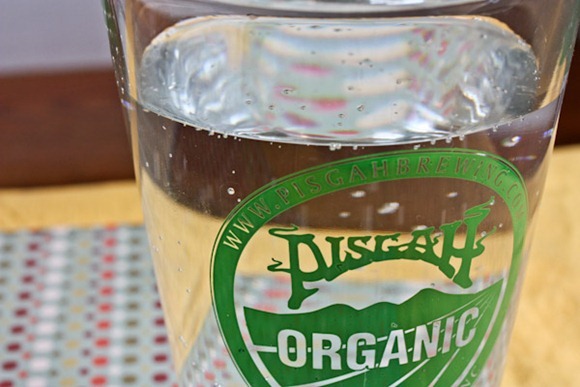
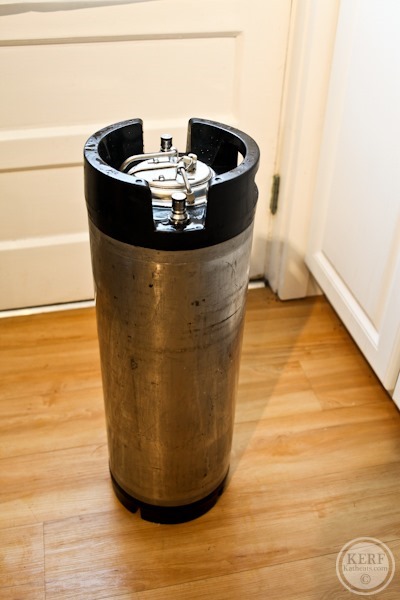
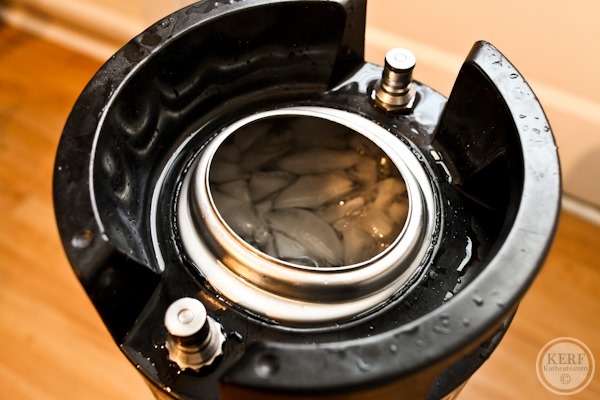
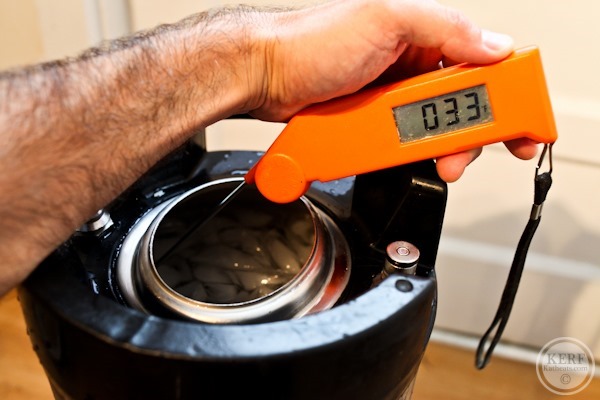
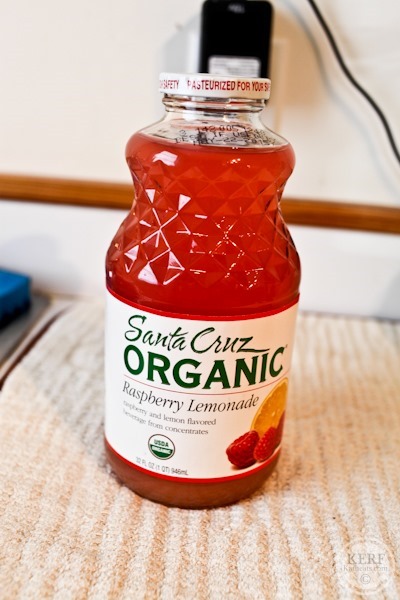
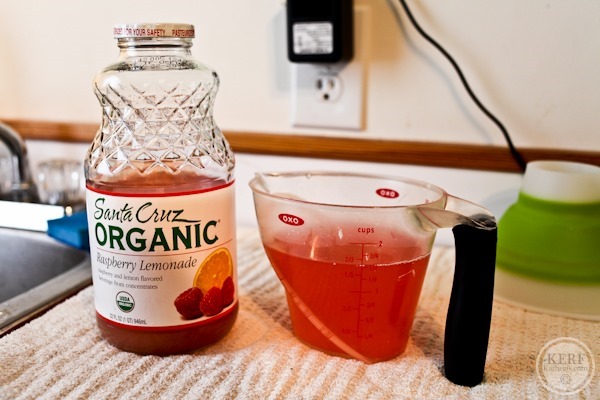
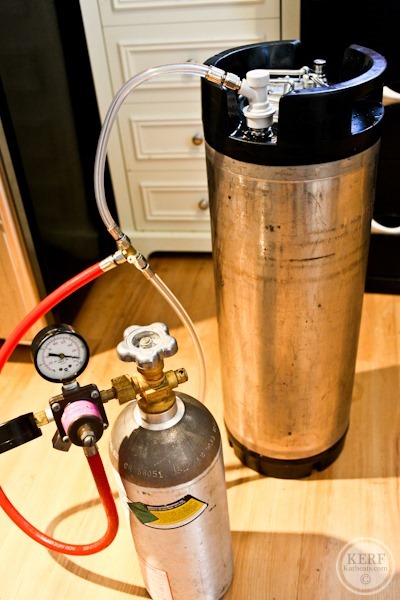
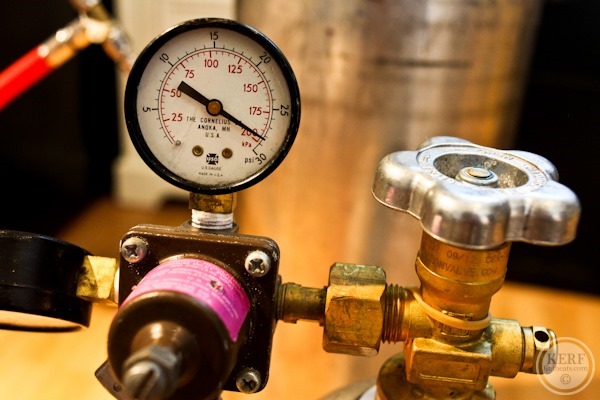
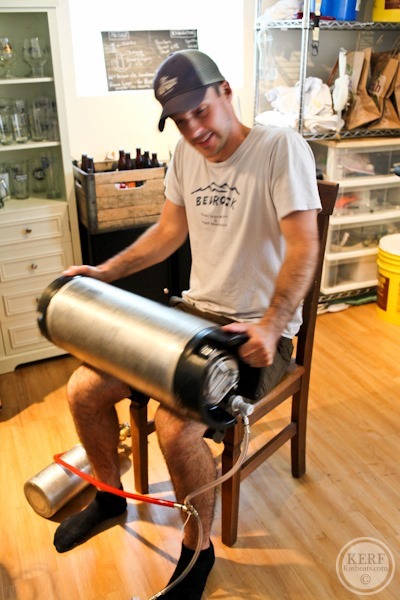
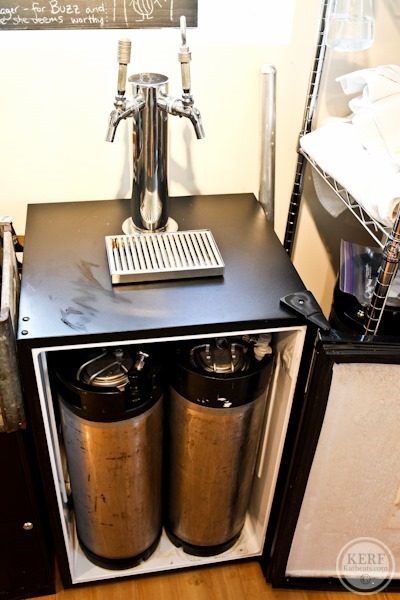
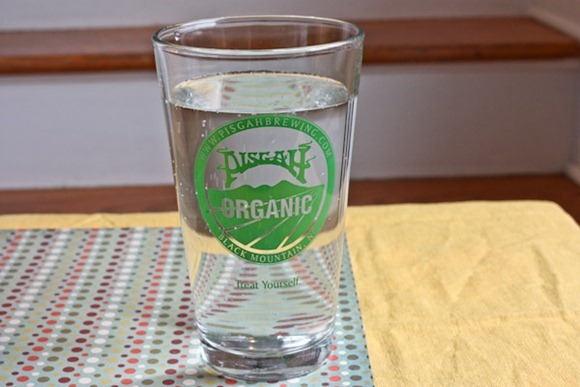
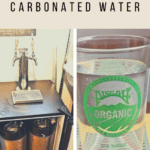
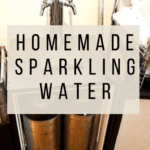
Kori says
I just love your guest posts, Matt! You have a great sense of humor, and I think you and Kath compliment one another perfectly. I wish I had the equipment and patience to do this myself, but unfortunately, I’ll still be buying mine for the ole store. But this post was very informative. Thanks!
Jackie says
This is so cool! I wish I could do this at home too! It would save so much money!!
Anele @ Success Along the Weigh says
Pretty cool and for the cost, can’t beat it! (Or shake it?) 🙂
Molly says
I’ve always wanted to know how to make sparkling water. Thank you. Your husband is a champ for shaking the Keg. I’ll either need to work at my muscles or have a man help me out! You are so creative.
Anna Ming says
Hahahahahaha I can’t stop watching that vine ahahaha!!
Jeri says
You and Matt amaze me with your home “inventions”. You guys have so much fun!
Linda says
My husband has a 2 tap kegerator and id love to try this! Have you tried reduced or low calorie juice with it? Ocean Spray makes many great 5 calorie per serving juices.
Leah says
I love sparkling water and drink it pretty much nonstop all summer, but I use a sodastream. With my Bed, Bath and Beyond 20% off coupon is was well under $100. http://www.sodastreamusa.com/
Karen says
Yeah, a sodastream is much easier and more accessible to most people. I exchange my canisters at Bed, Bath, and Beyond when I have 20% off coupons, too.
Matt says
Definitely agree those are more accessible. I’ve never looked into them, though – what does it end up costing you for X amount?
Grace says
It’s really, really cheap. The refill bottles of C02 cost about $20, and they lasted us about 6 months at a time. We would go through maybe 4-8 liters a week of water. So you’re looking at an initial cost of about $100, then maybe $40-50 a year for sparkling water, so it costs about the same as what you have outlined above. It’s also way more accessible and easier than kegging carbonated water, unless you already brew beer and have the space and equipment.
Chelsea says
I’ve recently found that at least some Staples locations (maybe all, I don’t go to many) carry Soda Streams, funny enough, and they’re another good store at giving coupons. The exchanges are $15, but we’re usually getting them for about $12, I think. Hope that can be helpful to other Soda Stream users if you (like me) don’t have a BB&B handy.
Kelly says
I never go get a C02 replacement canister unless I have a coupon! Thanks Chelsea because I’ll watch for staples coupons too, now!
Tonya says
Woo Hoo–a Matt post! Love it when your rooster visits the hen house. 🙂 “Shakin’ the keg!” HAHAHA
Ali @ Peaches and Football says
awesome post Matt! 🙂
I’ve never seen anyone make sparkling water before. I could see this being a huge hit at summer outdoor parties!! Nice job shaking – thank goodness it only takes a few minutes. What a workout! 🙂
Katie says
Wow! Yeah, I won’t be trying that while I live at home with my parents. But maybe some day!!
David @ From Ballparks to BBQ says
I love that you have a Kegerator. That’s awesome.
Melissa says
Very interesting concept! It looks very refreshing and of course, I am all for carbonated beverages!
Tiffany says
Awesome post Matt!
I’ve recently been adding rose water to my hot teas and ice waters. So delicious. Kath, have you tried rose water before?
KathEats says
I haven’t but I love rose so I bet I would love it
Tiffany says
I think you would love it! this is the brand my family buys:
http://www.amazon.com/Cortas-Rose-Water-10-oz/dp/B000LQL9M6
hopefully you can find it where you live. You only need a small bit maybe 1T or less for a glass.
By the way, Barney Butter has new flavors! Honey flax and more. Have you tried them?
KathEats says
Oh fun, I haven’t tried them! Thanks for the link
Karen says
That video of you has me marveling at your endless energy and ingenuity (and patience) while at the same time cracking up:) Matt – you are so adorable 🙂
Renee King says
Wow, that really does look like a lot of fun. Matt you are very brave to be on camera, and I would guess very strong to be able to shake that big thing. This seems very similar to the soda stream only a lot bigger and I am sure a lot better.
So I have a question: Does the plan carbonated water end up tasting like seltzer water? I really don’t care for seltzer water just plain, however I do like the flavored waters you buy at the store.
This makes drinking water a lot more fun, and you can customize it to your liking. I have been in love with drinking water with lemons, but the lemonade just sounds more interesting.
Great post, thanks
KathEats says
It is like seltzer, but the lemonade adds just a touch of flavor
Matt says
Even when you make it plain it’s pretty tasty. I’d compare this more to sparkling water you can buy like Poland Springs brand. It doesn’t have that minerally taste like some club sodas out there.
Melissa says
This isn’t something we’d try at home – I’m not much on fizzy water – but this is so neat! 🙂
Susan H @ The Food Allergy Chronicles says
Oh, that does sound refreshing! 🙂
she says
Love your set up in the garage! The fizz on demand sounds great- but Kath what’s the environmental impact of the chemicals & gases? (I assume no greater than buying fizzy water at the grocery store?)
KathEats says
I’ll let Matt speak to the chemicals, but I don’t think they are harmful (since they are safe for human consumption). And the tank is just CO2
Matt says
Frankly I don’t really know. There are many ways to produce CO2… or really we should say “harvest” it because many of them involve catching the CO2 produced by organisms during fermentation. No idea about the environmental impact.
One thing I’m curious about is the consumption of carbonated beverages. CO2 when dissolved in solution creates carbonic acid. I don’t know how bad this is for you. I mean, our stomachs are pretty dang acidic so it’s not like we can’t consume acidic food. There’s probably damage done to our teeth enamel, though it may be minimal. No clue!
KathEats says
Your lungs and kidneys know how to compensate
Ray says
You are correct- carbonic acid does serious damage quickly to tooth enamel. My dentist is quick to point out that still water is much healthier than sparkling water for this reason. I love sparkling water though!
she says
Thanks! Also, I’d love to read a weekly recap of what exercises you do. As a busy mom I love the format of reading one post & getting a condensed view of all the food you’ve eaten. Keep up the great work!
KathEats says
I’ll try to work this in : 0
Grace says
We’ve had the same set-up for years (my husband also home-brews and force-carbonates, so it was really easy to use an empty keg for sparkling water), as do a number of friends who also home-brew, and I’ve never heard of sitting there and shaking a keg for 5 minutes! Nor does anyone I know use ice water. I can’t imagine that it would effect the taste, or the carbonation of the water. What differences do you notice from those steps? Also, don’t you guys get tired of the same flavor of carbonated water for so long? It takes us quite a while to go through 5 gallons, so we just carbonate the water then add juice or syrups or other things to our individual glasses.
And we had a SodaStream for a long time before my husband went to force-carbonation, and loved it. I would recommend a SodaStream unless you already have an extensive home-brew set-up (including force-carbonation) with a dedicated beer fridge.
Matt says
I’m too impatient to hook up the keg and wait a week – I want water (and beer!) now! If you use the shake method with beer you have to be careful not to overcarbonate – that’s really annoying and somewhat difficult to fix.
We love the sparkling water and will frequently drink several glasses each every night – we can go through 5 gallons in about 7-10 days! I also try to make the flavors fairly simple so it’s still mostly just sparkling water and not so much a “soda.”
Grace says
I’m confused? We don’t have to wait a week… I’d have to ask my husband for the details (since he’s the brewer and not me!) but when he re-fills the keg with water he just rocks it back and forth a bit while he’s carbonating, and it’s ready right away. And I’ve never heard of pre-chilling the water with ice, ours has always tasted fine.
And wow you guys drink a lot of carbonated water! We each have a glass or two a day, maybe, and it lasts us almost a month. I’m also not a fan of sweet things and prefer my water plain more often than not.
Grace says
I wanted to come back and clarify my response now that I’ve gotten a chance to talk to my husband (and learned WAY more than I ever wanted to know about force carbonation, ha!). He said that he doesn’t like using the method you recommend for beer (force carbonation + shaking) because of C02 burn, he prefers the “wait a week” method for his homebrew. But he does use cold water for carbonation (which I hadn’t realized, although it’s not ice water) and he said that he does shake it a bit when carbonating it, although he doesn’t need to shake it for 5 minutes straight. I obviously am not that observant when he’s working with his beer stuff! 🙂
It’s cool to see other people’s home brew set-ups!
Billy says
Wow this grace lady comes across as a real c-word.
joelle (on a pink typewriter) says
How clever!!
Christina @ The Beautiful Balance says
Haha that video of Matt is hilarious! This is such an awesome post that I would love to try but sadly don’t have the materials. Time to get my boyfriend started on home brewing like he has been talking about 🙂
Marissa@ohhhsolovely says
this is pretty cool. i’ve actually just discovered sparkling water & have been buying it recently. the carbonation seems to help me get my huge vitamins down more easily in the morning. it’s also just a bit more fun to drink than plain water!
Zoe @ Chocolate Covered Chia says
This is awesome! I LOVE carbonation.
Kathleen says
Love the info- our family uses the Williams-Sonoma Penguin all the time. Sparking lemonade is our favorite! 🙂
Thomasina says
How is this better than a sodastream? They are a lot less than buying a brewers keg system just for carbinated water.
KathEats says
It’s not supposed to be. People have just asked us about our kegs of sparkling water over the years and this is our post on how we do it.
Tom Hargrave says
A good used soda keg will cost you about $45.00. The rest of the parts will run you less than $100 unless you go with a beer tower like these folks did, then you can plan for about $200.
The real pay-back comes from consumables over time. A 5# tank of CO2 costs about $15 to exchange at your local welding shop or gas distributor. SodaStream’s 60 Liter CO2 exchange runs about the same and but their 60 Liter cartridge only contains 14.5 oz of CO2 – that’s less than one pound of CO2 for the same price! It won’t take long for the cost savings in CO2 alone to more than cover your original investment, plus you are now making carbonated water in quantity & not just 2 liters at a time.
Matt says
Hi Tom, I got most of my kegerator parts from you! Thanks!
Katherine says
Looks delicious! That’s neat you can make it!
http://therealfoodrunner.blogspot.com
Tess @ Tips on Healthy Living says
I bet this tastes amazing, and it must beat anything store-bought. What other flavors would you recommend trying?
KathEats says
We’ve done it with fresh oj and lemon too. And plain!
Elise @ Expeditions of Elise says
Rather unexpected, but this post helped me on my chemistry final today! There was a question about gas solubility in water, and I was reminded that gases dissolve in COLD water better (hence your use of ice water). So thanks 🙂
I love sparkling water, and if I didn’t already have a Soda Stream I’d probably consider this method for meeting all of my sparkling water needs.
Kel says
With your love of Kombucha have you ever considered brewing your own? I have been making my own for about 2 months and it is very easy! With a beer brewer in the house, I bet he would be equally as fascinated with the SCOBY and flavoring options!
KathEats says
I should give it a try…
Matt says
I’ve been a little scared to contaminate the brewery with all the wild organisms used to make kombucha – they’re very resilient and can easily ruin beer (by turning it into kombucha!)
But yeah, the lure of fermentation is always exciting…
Nina says
Water kefir is pretty harmless and easy to contain!
robin says
I do not like fizzy water at all but the flavored stuff sounds great!
Tom Hargrave says
This is a great article. And since you already have a 2 keg kegerator there is a much simpler way to carbonate your second keg and to have a continuous supply of carbonated water without adding ice or shaking. Here’s the process:
1. Carbonate your first keg exactly as outlined in this article and put it in the kegerator. This gets you carbonated water NOW.
2. Go ahead and fill the second keg with cold tap water, close the keg, put it in the kegerator and hook up the CO2 line.
3. As you are drawing carbonated water from the first keg the second keg will carbonate itself & will be ready within 2 weeks.
4. Unless you drink massive amounts of carbonated water, the second keg will be ready when your first keg is empty.
5. Repeat the process by filling the first keg & placing it back in the kegerator, & hooking up the CO2 line.
Matt says
Great advice, if there weren’t already a (shaken force-carbonated) beer on tap right next to it! But yeah, I also have a three way manifold in my other fridge for other kegs and frequently have many things on the way to carbonation. It’s rare, though, that I take the time to wait for something to carbonate. I’ll at least get it close by shaking and I’ve gotten pretty good about not over-doing it.
Kaila @healthyhelperblog! says
Wish I had the equipment to do this at home! I do have a question though: how do you get vines to show up in your posts?
KathEats says
Find them online through Twitter and there is an embed button
Steven Hong says
I also go the DIY route, and was working on a very similar post. We’ve been carbonating water for almost a year now. Since I make batches of 2 liters at a time, it’s a bit easier than dragging a keg around. Either way, it’s far, far, far cheaper than a Soda Stream.
Don’t know if you allow a link or not, but my system is here:
http://techiefather.com/food/diy-carbonated-water
Alex @ Delicious Knowledge says
You’re so right- I will probably never try this at home…. unless my husband decides to start brewing his own beer, but it looks so cool and fun to try! Thanks for posting- just in case! 🙂
Lauren @ Oatmeal after Spinning says
This is very cool!!
Hmm… want to come out to Colorado and set up everything for home brewing for us?? 🙂
Amanda - Small Home Big Start says
Great guest post, Matt! I used to have a retro soda maker that used CO2 cartridges and loved creating freshly made soda when I needed it, but it never lasted very long. This would be a great alternative if you’ll willing to make the investment for home brewing. Thanks for sharing!
lorraine says
Hi, I was wondering if you disconnect the co2 after shaking it and can i store the keg at room temp? I don’t have that much ref space to keep a keg and was wondering if this will affect the soda water?
KathEats says
I’m pretty sure you have to keep the CO2 attached or it will decarbonate
Clearly says
Thanks for post. This is great and all, but it’s nothing like Clearly Canadian – do you remember the effervescent goodness from a long time ago? Clearly Canadian is re-launching the original formulas in glass bottles via a fan-led campaign to bring back into production.
https://www.clearlycanadian.com/?rn=101722
Let’s support the campaign and make matters that much easier!
KathEats says
I have missed Clearly Canadian for years!! This is exciting.
Becca says
I just have to say THANK YOU. My beau is a Homebrewer and today showed me how he could get a cap for a 2L bottle that would allow him to make me bottles of carbonated water, so I asked about doing a whole keg- he thought there might be some problems with the process, so I googled it and your website came up- 1 hour later I was drinking fresh homemade, ice-cold sparkling water with NO cost extra to us and MUCH less waste.
KathEats says
Yay!
Anonymous says
I’ll be doing this tonight. I already have the setup for beer so it’ll be a piece of cake to do. I’m going to try mango lemonade! I might get the Perlick Flow Control faucet so we can fill some flip top bottles to bring to work. I heard with that faucet you can dial it down to a trickle and keep it carbonated.
Cheers
John says
This looks great. But I’ll be buying food grade CO2, no chance I’m buying CO2 from the welding shop or the sports store!
Jim B says
This is a great idea. I’ve been using “corny” kegs for years for my lemonades. I make “candy syrup” in the kegs and pressure it with N2 through a flash chiller for the most awesome lemonade. I use a handbuilt press to squeeze each quart individually.
Something in your video doesn’t make sense though. I see a line running from the regulator to the corny keg carrying the co2. But, there’s a “T” in that clear line. One end goes to the keg, the other disappears out of view without explanation. Can you explain that?
mike says
I moved into a new house with a keg system and I’ve been trying to figure this out for almost 2 years. This is the article that finally got my tap flowing!!!!
The key is to crank up the psi to get it to start flowing and then turn it back down.
THANK YOU SO MUCH!!!